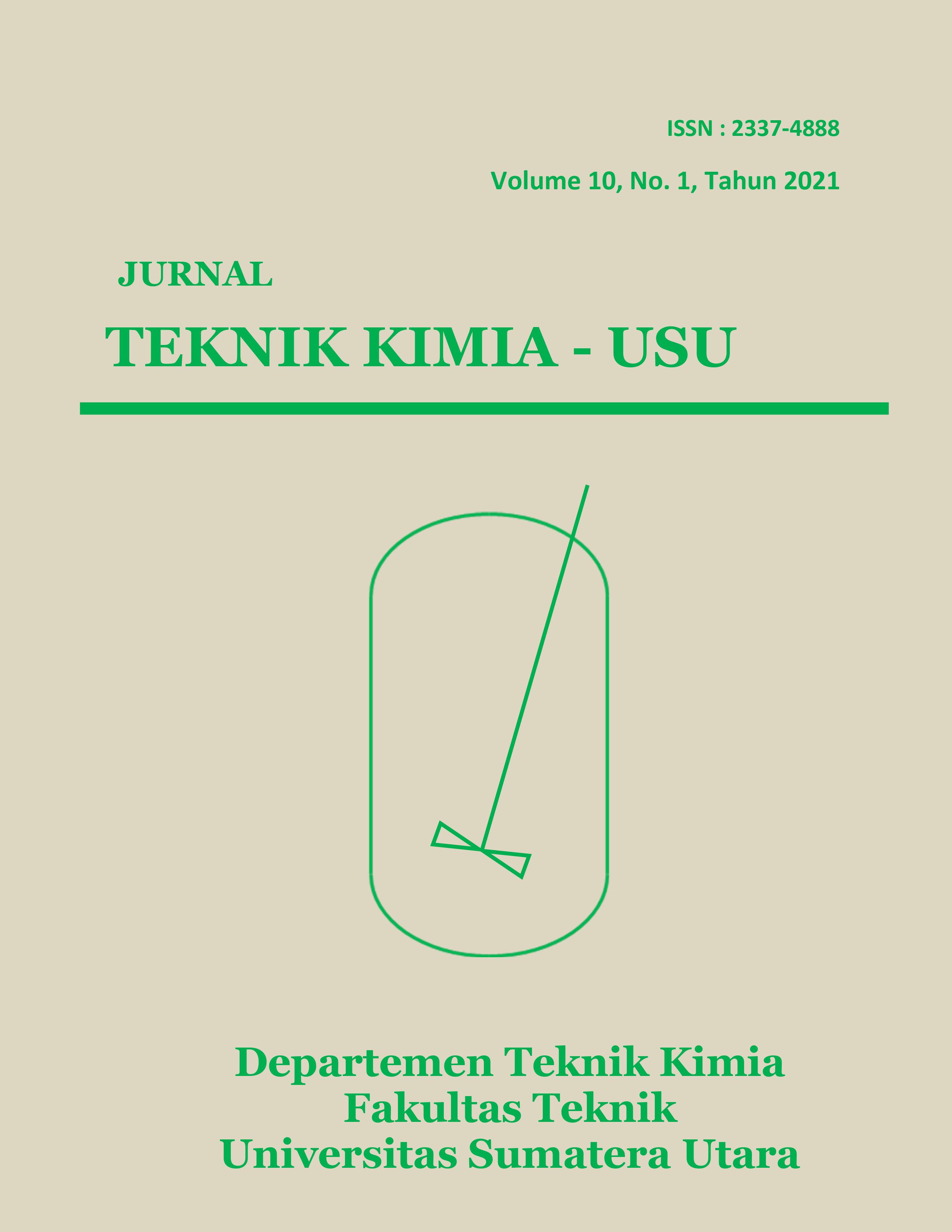Pemanfaatan Limbah Kulit Buah dan Sayur Sebagai Bahan Bakar Bioetanol dengan Variasi Konsentrasi Katalis
DOI:
https://doi.org/10.32734/jtk.v10i1.4552Keywords:
organic waste, hydrolysis, fermentation , distillation, bioethanolAbstract
Fossil fuels are included as non-renewable energy sources, so its presence in Indonesia is decreasing. One of the renewable energy sources that can be obtained easily is bioethanol, this energy is obtained from organic materials containing cellulose fibers. Cellulose is hydrolyzed on a catalyst and fermented to obtain bioethanol. The aim of this study was to determine the effect of variations in the concentration of catalysts in the production of bioethanol from market organic waste (fruit peels and vegetables). There are three stages of converting organic waste into bioethanol, including converting green vegetables waste and fruit peels (polysaccharides / cellulose) into monosaccharides (simple sugars) through a hydrolysis process followed by a fermentation process using Saccharomyces cerevisiae and EM4, then separating ethanol and water using a distillation process. The resulting products are analyzed using a quantitative test to determine density and a qualitative test to determine color change. The results showed that the ethanol obtained from the addition of H2SO4 catalyst with concentrations of 0.5% and 1% had almost the same specifications as standard ethanol based on density calculations and color change tests. The highest ethanol yield percentage was obtained from the concentration of H2SO4 1%.
Downloads
References
Anonim, Dokumen Rencana Strategis Sekretariat Jenderal Kementerian Energi dan Sumber Daya Mineral Tahun 2015-2019, KESDM, Jakarta Pusat, 2019, p.1-106.
A. D. Kurniawan, Semin, and T. Suprajitno, “Analisa penggunaan bahan bakar bioethanol dari batang padi sebagai campuran pada bensin,†J. Tek. ITS, vol. 3, no. 1, 2014.
D. Seftian, F. Antonius, and M. Faizal, “Pembuatan etanol dari kulit pisang menggunakan metode hidrolisis enzimatik dan fermentasi,†J. Tek. Kim., vol. 18, no. 1, pp. 10–16, 2012.
W. Wusnah, S. Bahri, and D. Hartono, “Proses pembuatan bioetanol dari kulit pisang kepok (Musa acuminata B.C) secara fermentasi,†J. Teknol. Kim. Unimal, vol. 8, no. 1, p. 48, 2019.
M. Jamaliah, “Sintesis etanol melalui reaksi hidrogenasi heksil asetat dengan menggunakan berbagai katalisâ€, Skripsi, UIN Syarif Hidayatullah, Jakarta, 2011.
D. E. Hasianna Purba, I. E. Suprihatin, and A. A. I. A. M. Laksmiwati, “Pembuatan Bioetanol dari kupasan kentang (Solanum tuberosum L.) dengan Proses fermentasi,†J. Kim., vol. 10, no. 1, pp. 155–160, 2016.
S. Miskah, A. Anugrah, and Gunadi, “Pemanfaatan Kulit telur sebagai katalis biodiesel dari campuran minyak jelantah dan minyak kelapa sawit,†J. Tek. Kim., vol. 22, no. 2, pp. 54–61, 2016.
F. Apriliani, Asteria dan Agustinus, “Pembuatan Etanol dari kulit pisang secara fermentasi,†J. Teknol. Kim. dan Ind., vol. 2, no. 2, pp. 177–180, 2013.
F. Hanum, N. Pohan, M. Rambe, R. Primadony, and M. Ulyana, “Pengaruh massa ragi dan waktu fermentasi terhadap bioetanol dari biji durian,†J. Tek. Kim. USU, vol. 2, no. 4, pp. 49–54, 2013.
D. Pinata, “Uji kualitatif etanol yang di produksi secara enzimatis menggunakan Zymomonas mobilis permeabelâ€, Skripsi, Institut Teknologi Sepuluh November, Surabaya, 2011.
L. O. A. D. Asidu, M. Hasbi, and P. Aksar, “Pemanfaatan minyak oli bekas sebagai bahan bakar alternatif dengan pencampuran minyak pirolisis,†J. Mhs. Tek. Mesin, vol. 2, no. 2, pp. 1–7, 2017.
F. Asip, B. Febrianti, and S. Gibreallah, “Bioetanol dengan bahan baku sabut kelapa,†J. Tek. Kim., vol. 23, no. 3, pp. 157–165, 2017.
D. Anisah, Herliati, and A. Widyaningrum, “Pemanfaatan Sampah sayuran sebagai bahan baku pembuatan bioetanol,†Konversi, vol. 3, no. 1, pp. 13–18, 2014.
K. Kusmiyati, “Reaksi Katalitis esterifikasi asam oleat dan metanol menjadi biodiesel dengan metode distilasi reaktif,†Reaktor, vol. 12, no. 2, p. 78, 2008.
A. Sukowati, Sutikno, and S. Rizal, “Produksi Bioetanol dari kulit pisang melalui hidrolisis asam sulfat,†J. Teknol. dan Ind. Has. Pertan. Vol., vol. 19, no. 3, pp. 274–288, 2014.
R. Muin, D. Lestari, and T. W. Sari, “Pengaruh konsentrasi asam sulfat dan waktu fermentasi terhadap kadar bioetanol yang dihasilkan dari biji alpukat,†J. Tek. Kim., vol. 20, no. 4, pp. 1–7, 2015.
A. Rachmayanti, R. M. Sari, and A. F. Ilhamdy, “Proses sakarifikasi dan fermentasi terpisah pada produksi bioetanol dari bahan baku rumput laut Sargassum sp.,†Marinade, vol. 2, no. 1, pp. 19–28, 2019.
Y. V. Simatupang, I. M. Mahaputra Wijaya, and N. S. Antara, “Isolasi dan karakterisasi bakteri potensial penghasil etanol dari industri arak Bali di Karangasem-Bali,†J. Rekayasa Dan Manaj. Agroindustri, vol. 7, no. 1, p. 58, 2019.
Downloads
Published
Issue
Section
License
Copyright (c) 2021 Jurnal Teknik Kimia USU

This work is licensed under a Creative Commons Attribution-ShareAlike 4.0 International License.

















